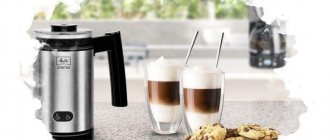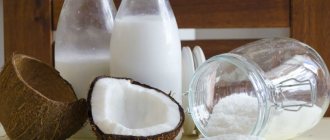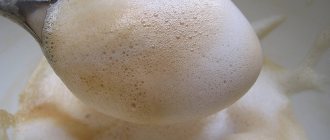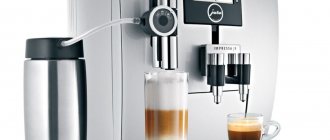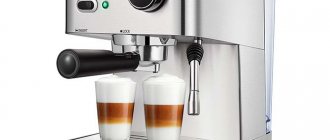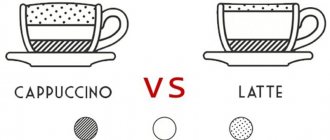August 9, 2013 Equipment and accessories
A pitcher is one of the barista’s tools, a container for frothing milk for cappuccino or latte. He is also the milkman or jug (jag). To prepare some coffee drinks (cappuccino and latte), milk foam is added to freshly prepared espresso.
The optimal utensil for preparing milk foam is a pitcher - a special stainless steel jug. Metal is predominantly used for their manufacture due to its good thermal conductivity, although there are also options made of aluminum, ceramics, glass and plastic, but they are not considered reliable.
Milk pitcher concept
A pitcher is a cone-shaped jug with which baristas get foam when preparing lattes or other coffee drinks. Such utensils are better suited for hand beating than mugs, shakers, and glasses.
Purpose of use
Jag is used in the process of frothing milk for lattes or cappuccinos. It can also be used to prepare espresso foam. The device will also be needed for latte art and decorating drinks with patterns.
Who needs it
The container is needed for manual beating. It can be purchased not only by a professional barista, but also by anyone who wants to drink coffee with foamed milk in the morning.
The need for a pitcher will not arise for owners of coffee makers or coffee machines with an automatic or semi-automatic cappuccino maker. If you purchase a separate frother, you can also avoid purchasing a jug.
How to froth milk in a pitcher?
The milk pitcher significantly facilitates the work of making soft and airy foam for cappuccino or latte.
To ensure that the foam is not liquid and does not spread throughout the glass within the first minutes, it is necessary to adhere to the following sequence of actions:
- Fill the pitcher with cold milk.
- Place the steam wand into the milk. How you position it just depends on how you feel most comfortable. Some find it convenient to place it on the spout of the jug, while others simply hold it in the center of the pitcher.
- Tilt the cappuccino maker approximately 45 degrees.
- Place the steamer one centimeter from the surface of the milk.
- Turn on the steam and hold the bottom or sides of the vessel. This way you can monitor the temperature of the milk mass.
- Turn on the steam at full power. Make sure the milk rotates in a circle. When you hear whistling, you know that the product has begun to whip. As soon as you hear a hissing sound, immediately lower the pitcher. A hissing sound indicates that the milk is saturated with air. After the characteristic sound, the pitcher should be immersed noticeably lower than when large bubbles appeared.
- At the moment the bottom of the vessel begins to heat up, lower the steamer and move it away from the wall of the pitcher. The milk should still rotate in a circle, at the same speed as before.
- You need to whip the foam until the bottom of the pitcher is completely heated. The process can be called complete when the temperature reaches 60-70 degrees Celsius.
- Turn off the steam supply and remove the steam wand.
- Do not add foam to your coffee drink. To begin, mix the consistency in the pitcher and tap the bottom of the vessel on the table. Knocking will get rid of any large bubbles that have arisen.
- Next, you can fill the cup with the resulting milk mass. The foam should be poured along the near edge of the cup. Make sure that the coffee drink and foam are thoroughly mixed together. Gradually move the pitcher from the edge of the cup to the middle and fill to the end.
This way you get a coffee drink with a balanced, rich taste.
For more information on the beating technique, watch the video:
Criteria for choosing the right milk jug for coffee
When choosing, consider the volume of the product, material, and the presence of a handle.
Material of manufacture
Pitchers are made from a number of materials:
- Of stainless steel. The material is best suited for making milk jugs. The good thermal conductivity of the metal allows the barista to sense in a timely manner that the contents of the container have become hot and stop whipping. Steel does not react with food and does not impart an unpleasant taste or odor to the drink.
- Plastic. Pitchers made from this material are cheaper. The product, however, is easier to damage during operation. In addition, the material reacts with the contents of the container, causing the coffee to have an unpleasant aftertaste and spoil the aroma.
- Aluminum. Such jags are not very comfortable due to poor thermal conductivity. It will be difficult for baristas to keep track of when the milk has warmed up. Because of this, foam with a boiling taste and bitterness may get into the drink.
- Ceramics. Ceramic products are not very convenient due to their fragility. In addition, their thermal conductivity is worse than that of metal, which will make it difficult for beginners to work with. Some housewives, however, prefer ceramic pitchers because of their appearance.
Materials for making a pitcher.
Pen
For beginners, it is better to choose products with a handle that is comfortable to hold. Experienced baristas can purchase a milk jug that does not have this part at all.
The product has a comfortable handle.
Volume
The volume is selected depending on how many people the coffee will be brewed for. To whip up foam for one drink, a container with a capacity of 100 ml or more is suitable.
For two, it is better to choose a jug with a volume of 350 ml or more. If you drink latte or cappuccino in the office, or prepare it for a large family or company, it is recommended to purchase a milk jug that holds 1-2 liters of liquid.
Containers with different volumes.
How to choose a milk maker
Housewives choose milk pans according to several criteria:
- The volume should not exceed two liters; large quantities should not be prepared in such containers. For a small family with a child, a small one is suitable; it is convenient to store it at hand;
- Bakelite handles do not get hot, but metal ones are more practical;
- A removable or built-in whistle on the water pipe eliminates the need for constant monitoring of the milk so that it does not run away;
- Housewives prefer glass lids so that they can observe the process of heating milk or cooking food.
A removable or built-in whistle on the water pipe eliminates the need for constant monitoring of the milk so that it does not run away.
Additional Capacity Options
When choosing cookware, consider a number of additional options.
Wall thickness
Beginner baristas should choose thin-walled products. When using such pitchers, it is easier to determine the temperature of the contents. Experienced professionals can buy cookware with thick walls. Such jags take away some of the heat, so you can froth the milk longer and get a more fluffy, delicate foam.
Built-in thermometer
The built-in thermometer allows you to accurately determine how hot the milk is. This function is especially convenient for beginners who have not yet learned how to stop whipping in time.
The cost of jags with a thermometer, however, is much higher than that of simple containers, and you won’t be able to find such utensils in any store. Sensors often break down and show incorrect information. It is better for beginners to use an immersion thermometer, and baristas are trained to determine the degree of heating by tactile sensations.
Pitcher with built-in thermometer.
Form
Consider the shape of the spout if you are going to do latte art. To create designs on the surface of coffee, you will need a product from which milk will pour out in a thin stream.
Pitcher with a long nose.
Color
Color coating has no practical use. Housewives, however, often choose bright pitchers that match the style with other dishes.
Review of milk makers and models
Several companies are considered the main manufacturers of cookware with a water bath effect.
Products "Bekker", "Smile" - buckets with a capacity of 1.5 liters. These are stainless steel milk pans with a whistle. They are available with a mirror surface and in color. There are models with and without covers. Both brands produce saucepans with ergonomically shaped bakelite handles. They do not heat up during the process of heating water or boiling milk.
The handles do not heat up when heating water or boiling milk.
Mayer&boch – 1.5 liter saucepans, equipped with a metal lid, have a built-in whistle. The plastic handle is resistant to open flames; it is not recommended to use such cookware on a gas stove; it is ideal for electric and glass-ceramic stoves.
Mayer&boch – 1.5 liter saucepans, equipped with a metal lid, have a built-in whistle.
Models with induction inserts that can be used on all hobs, including induction:
- Winner – dishes with a capacity of 1.2 liters. It is easy to recognize by its mirror surface with three matte stripes and a long metal handle. It warms up slowly, but it is better to grab it so as not to burn your hands;
It is easy to recognize by its mirror surface with three matte stripes and a long metal handle. - Another popular brand is Tescoma Presto. They produce models of different capacities and equip the saucepans with convenient lids;
They produce models of different capacities, and the saucepans are equipped with convenient lids. - Tescoma Home Profi - cookware with two walls with a capacity of 1.8 liters. Thanks to the metal handle, the pan can be used for cooking in the oven;
Thanks to the metal handle, the pan can be used for cooking in the oven. - Tim's milk cooker with a whistle, 2 liter, differs from other models in its steam vent and heat-accumulating bottom. The steel handle carries the heat in the oven.
Tim's milk cooker with a whistle, 2 liter, differs from other models in its steam vent and heat-accumulating bottom.
Each housewife decides which type of milk utensil to choose independently, taking into account the composition of the family. A saucepan with a water bath effect is the right gift for a young family. Such dishes are useful in any home, they do not take up much space and are practical. With it, milk or porridge will never burn.
Places of purchase and average cost in stores
You can buy a milk jug in a specialized boutique that sells tableware for coffee shops, bars, or coffee accessories. Products are also offered in the online stores Boffo, Tasty, and Yandex.Market. The cheapest pitchers can be found on AliExpress.
The cost depends on the volume and material. A 100 ml ceramic pitcher can be bought for 400 rubles. A metal product is more expensive: the cost starts from 700 rubles.
Milk jugs holding 1 liter or more sell for 2,400 rubles. The price increases additionally for painted products, jugs with Teflon coating or a thermometer.
Buy quality pitchers from specialized coffee shops.
Step-by-step instructions for whipping
To get a thick foam, follow the algorithm:
- Using the steam tap, remove condensation from the container, which can spoil the taste of the drink.
- Fill the pitcher halfway with milk. Immerse the steam tap into the liquid by 1-1.5 cm and use it to heat the contents of the container to +37°C. At this stage, the milk should not be overheated, since its taste will deteriorate and the foam may not be thick enough.
- Open the tap to start frothing. Bubbles should appear over the entire surface of the liquid.
- Keep an eye on the sounds as you go. There should be a uniform hissing sound. Gurgling or muffled sounds indicate that the faucet is immersed too deep. If the milk splashes out during the process, the immersion depth is insufficient.
- Then proceed to steaming. This phase lasts from 5 to 15 seconds. Stir the milk continuously in a circular motion as you go. This way the contents of the container will become homogeneous and evenly warm up to +70°C.
- When the process is complete, remove the faucet. Then lightly tap the sides of the pitcher to settle the bubbles. Shake the milk mass until it gets into the coffee.
Immediately after finishing work, wash the pitcher from any remaining milk.
Why doesn't milk froth?
Sometimes the milk foam turns out loose and settles quickly or does not form at all. If the device is working properly, then the problem is in the milk. Baristas know several whipping secrets:
- It is better to take milk with 3.2% fat content or higher.
- A high protein product is best. You can often find the inscription “For cappuccino” on the packaging. True, such milk costs more than regular milk.
Don't miss: What kind of milk froths well in a cappuccino maker?
The result of whipping depends on the initial amount of liquid. Cappuccinatore jugs need to be filled to approximately 1/3 of the total volume so that the milk covers the working nozzles. At the same time, there was enough space for the growing foam.


